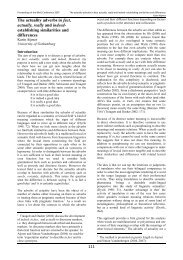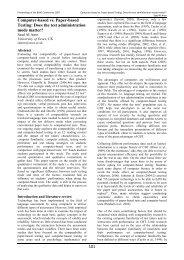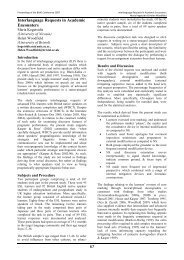Lexical development across second language proficiency levels
Lexical development across second language proficiency levels
Lexical development across second language proficiency levels
Create successful ePaper yourself
Turn your PDF publications into a flip-book with our unique Google optimized e-Paper software.
Proceedings of the BAAL Annual Conference 2009<br />
Newcastle University<br />
<strong>levels</strong> (L1-2). Off-list words showed a progression from proper nouns and<br />
words referring to everyday objects at the lower <strong>levels</strong> to words denoting<br />
more complex abstract notions and activities at the higher <strong>levels</strong>.<br />
At the level of multi-word sequences, we identified and analysed recurrent<br />
4-word lexical bundles <strong>across</strong> <strong>levels</strong>, having calculated their normed<br />
frequency (using Biber & Barbieri 2007’s 40/million cut-off), and selected<br />
those produced by three or more writers. Lower <strong>proficiency</strong> learners (E1/2)<br />
used a limited set of bundles (6/27 types) mostly taken from the input. E3<br />
learners mostly relied on their own resources (23 types), which resulted in<br />
fewer re-used bundles. Higher <strong>proficiency</strong> learners (L1/2) used even fewer<br />
bundles from the task prompts but more overall (66/91 types), suggesting<br />
greater creativity; task prompt re-use was 63-26% of lexical bundle types<br />
from lower to higher <strong>levels</strong>.<br />
Following Biber & Barbieri (2007), Cortes (2004) and Nekrasova (2009),<br />
we functionally classified bundles into: referential (identifying an object or<br />
attribute); discourse (indicating discourse structure); stance (conveying<br />
attitudes and epistemic evaluations) and special conversational (expressing<br />
politeness, inquiry and report). The most frequent bundles overall were<br />
referential, the number and variety of which increased from E1 to L2.<br />
Discourse bundles were rarely used at lower <strong>levels</strong>; only at L1/2 did<br />
learners use them much more often. Stance and special conversational<br />
bundles exhibited a gradual increase in number and variety with<br />
<strong>proficiency</strong>. The analysis of functions of lexical bundles in L2 output<br />
provides insights into the <strong>development</strong> of discourse organisation and<br />
reveals that communicative need may inform their use. Whilst referential<br />
bundles dominate at all <strong>levels</strong>, other functions are increasingly used at<br />
higher <strong>levels</strong>. Stance and special conversational bundles are used more<br />
often than discourse bundles by lower <strong>proficiency</strong> learners which may<br />
indicate that they are required earlier, possibly for establishing an<br />
immediate connection with interactants. Discourse structuring bundles are<br />
the <strong>second</strong> most frequent category for higher <strong>proficiency</strong> learners, which<br />
could be due to learners’ increased <strong>proficiency</strong> and the need to structure<br />
more complex messages.<br />
Key factors behind L2 acquisition of lexical bundles could be a low degree<br />
of perceptual salience, since many bundles are incomplete structural units;<br />
structural or semantic complexity; or their specific discourse functions.<br />
Input frequency may also be important; this is one avenue for further<br />
research.<br />
144







